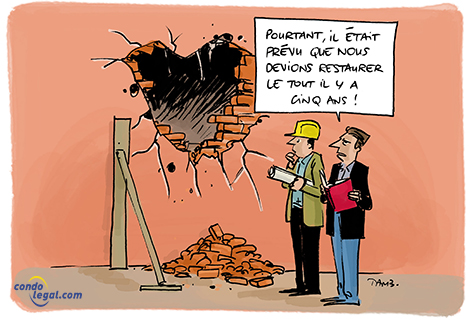Date published: 24/06/2024
Maintenance logbook

Every syndicate of co-owners has obligations regarding common portions maintenance. Article 1039 of the Civil Code of Québec provides that the object of the syndicate is the conservation of the immovable, the maintenance and the administration of the common portions. However, this section was amended following the adoption of Bill 16. At the end of the first paragraph, referring to the syndicate of co-ownership, it reads the following sentence: "The legal person must, in particular, see to it that the work necessary for the preservation and maintenance of the immovable is carried out."
This duty to preserve the immovable is exercised in particular by the setting up of a maintenance logbook.
Object
An indispensable co-ownership document, the maintenance and management logbook is in essence a register tracing the building history, as well as a register of all the operations already carried out or forthcoming thereon. Even though not mandatory, it increases a co-ownership’s resale market attractiveness. In addition, the directors, by availing themselves of such a logbook, demonstrate their concern for good governance and sound management. the installation of a maintenance book.
Immovable’s collective memory
This document contains the immovable’s main construction and technical characteristics and lists the various maintenance, upkeep, warranty and insurance contracts. It determines the work schedule under the asset management plan.
The logbook is all the more justified because syndicates experience frequent director’s changes. Without the logbook, the knowledge transfer between former and new directors is rarely assured. New directors are often not aware of the building’s state of repairs and of the history of prior interventions. Without a maintenance logbook, they must start from scratch and limit their actions to specific interventions. Not being a part of a comprehensive approach in a continuum of previous operations, such interventions are often unnecessary or, even worse, they may aggravate the building’s state of repairs.
Building history
To be useful, the maintenance logbook must contain all the information relative to the description of the immovable, including:
- The site history upon which the immovable is erected;
- The construction year and/or that of the renovation of the immovable (construction permit);
- The completion year of major work in the immovable, the identity of the enterprises that carried out such work, the plans, specifications, guarantees and workshops drawings;
- The immovable’s technical description (the architectural and engineering plans, the cadastral plan, the technical reports, the exemptions granted, etc.);
- The reception date of the common portions by the syndicate of co-ownership;
- The list of the common portions of the immovable, including their area or volume.
Additional information
The logbook should also include:
- The maintenance manuals, kept up to date and addressing the true needs of the building and of the equipment, systems and building components;
- The equipment and systems ‘contractual guarantees;
- References to the maintenance and upkeep contracts of common equipment, along with their expiry date;
- The maintenance strategy and planning, as well as its history and follow-up.
Dynamic tool
By means of the logbook, the directors can implement a heritage conservation policy and establish the priorities of a multi-year work plan. The maintenance logbook is also a useful tool for the professionals entrusted with a contingency fund study. The latter will benefit from the building history information, necessary to a more precise knowledge of its state of repairs and the building’s components foreseeable duration and deficiencies.
The logbook also allows professionals a better understanding of the effect of the maintenance policy implemented by the Board of Directors on the life expectancy of the building components. It is an essential tool for drafting the asset management plan, which defines the maintenance and upkeep policy.
Legal requirement
Section 1070 of the Civil Code of Quebec was amended in December 2019 by Bill 16 and February 2924 by Bill 31. Now, it contains a second paragraph (Article 1070.2) which states that « The board of directors causes a maintenance log to be established for the immovable which describes, in particular, maintenance done and maintenance required. The board of directors keeps the log up to date and has it reviewed periodically. ». It is a regulation of the Government that will determine the form, content and manner of keeping and revising the carnet and the persons authorized to draw it up. Additionally, the standards set forth in the regulation can vary depending on the characteristics of a building. Although this section is not yet in force, it is in the interest of any syndicate to immediately implement such a management tool.
Transitional measures and entry into force
Transitional measures have been provided concerning the implementation of the requirement to establish a maintenance logbook.
- For existing co-ownerships and certain newly formed ones (i.e., those where the special transitional meeting was held more than 30 days before the entry into force of the first regulation adopted pursuant to the second paragraph of Article 1070.2 of the Civil Code): the maintenance logbook should be obtained by the board of directors no later than the day after the third anniversary of the entry into force of the aforementioned government regulation (Article 151 of Bill 16).
- For newly formed co-ownership: two specific cases.
- In the case where the extraordinary transition assembly of a syndicate is held in the period starting 30 days before the entry into force of the regulation and ending 90 days after, the developer will have 6 months from the transition assembly to provide the logbook to the syndicate.
- In the case where the extraordinary transition assembly takes place more than 90 days after the entry into force of the concerned regulation, the promoter will have 30 days to provide the maintenance logbook.
The legislator has provided that this regulation could include a special regime to govern the recognition of equivalences for maintenance logbooks obtained by a syndicate in the previous two years.
 WHAT YOU SHOULD KNOW ! As soon as a building is built, the developer must provide a plan for its maintenance, so as not to postpone the completion of the various works necessary for its sustainability.
WHAT YOU SHOULD KNOW ! As soon as a building is built, the developer must provide a plan for its maintenance, so as not to postpone the completion of the various works necessary for its sustainability.
 WHAT TO KEEP IN MIND : The maintenance book is part of the syndicate's register provided for in article 1070 of the Civil Code of Quebec. In addition, new article 1106.1 of the Civil Code of Quebec will require the developer to provide the maintenance book to the syndicate within 30 days of the Special Transitional Meeting (special meeting).
WHAT TO KEEP IN MIND : The maintenance book is part of the syndicate's register provided for in article 1070 of the Civil Code of Quebec. In addition, new article 1106.1 of the Civil Code of Quebec will require the developer to provide the maintenance book to the syndicate within 30 days of the Special Transitional Meeting (special meeting).
 WARNING ! In many cases, newly elected Board members are totally unaware of the state of repair of their co-ownership, such as, the ongoing maintenance plans, past operations, or even about common portions that need to be replaced. Thanks to the maintenance logbook, they can follow up and have a global vision of things to be attended to.
WARNING ! In many cases, newly elected Board members are totally unaware of the state of repair of their co-ownership, such as, the ongoing maintenance plans, past operations, or even about common portions that need to be replaced. Thanks to the maintenance logbook, they can follow up and have a global vision of things to be attended to.
Back to the factsheets





